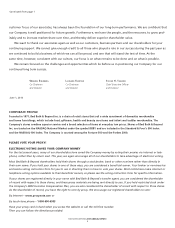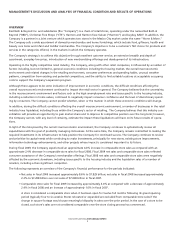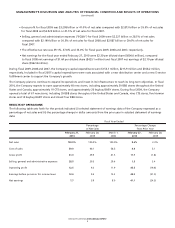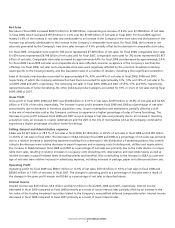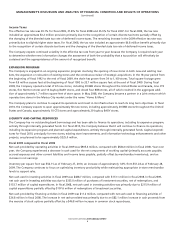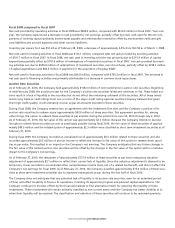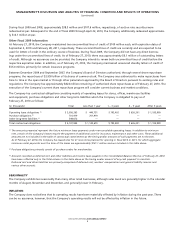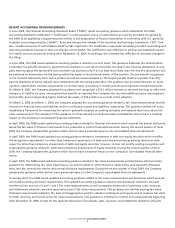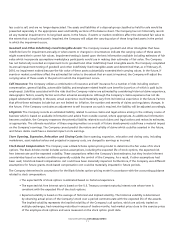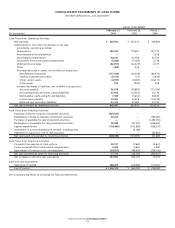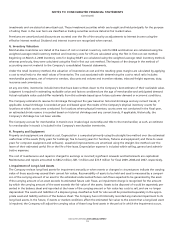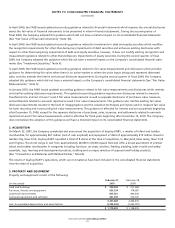Bed, Bath and Beyond 2009 Annual Report Download - page 14
Download and view the complete annual report
Please find page 14 of the 2009 Bed, Bath and Beyond annual report below. You can navigate through the pages in the report by either clicking on the pages listed below, or by using the keyword search tool below to find specific information within the annual report.
BED BATH & BEYOND 2009 ANNUAL REPORT
12
MANAGEMENT’S DISCUSSION AND ANALYSIS OF FINANCIAL CONDITION AND RESULTS OF OPERATIONS
(continued)
The Company is required to record stock-based compensation expense net of estimated forfeitures. The Company’s forfeiture rate
assumption used in determining its stock-based compensation expense is estimated based on historical data. The actual forfeiture
rate could differ from these estimates.
Income Taxes: The Company accounts for its income taxes using the asset and liability method. Deferred tax assets and liabilities
are recognized for the future tax consequences attributable to the differences between the financial statement carrying amounts
of existing assets and liabilities and their respective tax bases and operating loss and tax credit carryforwards. Deferred tax assets
and liabilities are measured using enacted tax rates expected to apply to taxable income in the year in which those temporary dif-
ferences are expected to be recovered or settled. The effect on deferred tax assets and liabilities of a change in tax rates is recog-
nized in earnings in the period that includes the enactment date.
The Company intends to reinvest the unremitted earnings of its Canadian subsidiary. Accordingly, no provision has been made for
U.S. or additional non-U.S. taxes with respect to these earnings. In the event of repatriation to the U.S., such earnings would be
subject to U.S. income taxes in most cases.
During the fiscal first quarter of 2007, the Company adopted updated accounting guidance related to income taxes. The Company
recognizes the tax benefit from an uncertain tax position only if it is at least more likely than not that the tax position will be sus-
tained on examination by the taxing authorities based on the technical merits of the position. The tax benefits recognized in the
financial statements from such a position are measured based on the largest benefit that has a greater than fifty percent likeli-
hood of being realized upon settlement with the taxing authorities.
The Company expects continued volatility in the effective tax rate from year to year because the Company is required each year
to determine whether new information changes the assessment of both the probability that a tax position will effectively be sus-
tained and the appropriateness of the amount of recognized benefit.
Judgment is required in determining the provision for income taxes and related accruals, deferred tax assets and liabilities. In the
ordinary course of business, there are transactions and calculations where the ultimate tax outcome is uncertain. Additionally, the
Company’s tax returns are subject to audit by various tax authorities. Although the Company believes that its estimates are rea-
sonable, actual results could differ from these estimates.
FORWARD-LOOKING STATEMENTS
This Annual Report, and in particular Management’s Discussion and Analysis of Financial Condition and Results of Operations and
the Shareholder Letter, contain forward-looking statements within the meaning of Section 21E of the Securities Exchange Act
of 1934, as amended. The Company’s actual results and future financial condition may differ materially from those expressed in
any such forward-looking statements as a result of many factors that may be outside the Company’s control. Such factors include,
without limitation: general economic conditions including the housing market, a challenging overall macroeconomic environment
and related changes in the retailing environment, consumer preferences and spending habits; demographics and other macro-
economic factors that may impact the level of spending for the types of merchandise sold by the Company; unusual weather pat-
terns; competition from existing and potential competitors; competition from other channels of distribution; pricing pressures;
the cost of labor, merchandise and other costs and expenses; the ability to find suitable locations at acceptable occupancy costs
to support the Company’s expansion program; the impact of failed auctions for auction rate securities held by the Company;
and matters arising out of or related to the Company’s stock option grants and procedures and related matters, including any
tax implications relating to the Company’s stock option grants. The Company does not undertake any obligation to update its
forward-looking statements.


